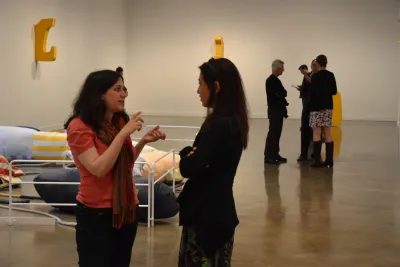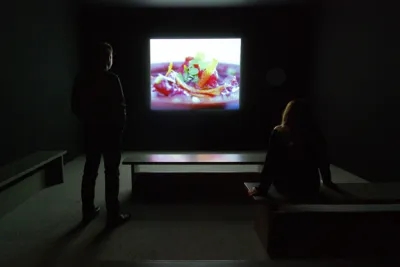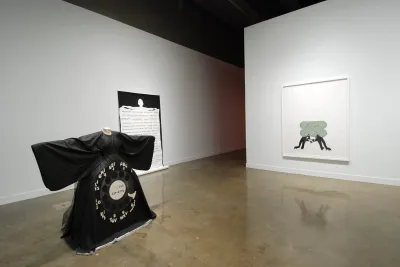Installation View, Frances Stark: This could become a gimick [sic] or an honest articulation of the workings of the mind, MIT List Visual Arts Center, 2010.
Pre-Reception Artist Talk & Opening Receptions: Frances Stark; Emily Wardill; Melvin Moti
Pre-Reception Artist Talk, 5:30 - 6:00 pm, Bartos Theatre
At 5:30PM, prior the to the opening reception for Frances Stark: This could become a gimick [sic] or an honest articulation of the workings of the mind, Emily Wardill: Gamekeepers without Game, and Melvin Moti: The Prisoner’s Cinema, the List Visual Arts Center is pleased to present an artist talk with exhibiting artist Frances Stark. This talk is moderated by LVAC curator João Ribas, and will take place in the Bartos Theatre.
Receptions, 6:00 - 8:00 pm
Join us for the opening reception of Frances Stark: This could become a gimick [sic] or an honest articulation of the workings of the mind, the first U.S. museum survey of the work of Los Angeles artist and writer, Frances Stark (b. 1967, Newport Beach, California). Spanning two decades of the artist’s work, the survey will feature more than forty drawings, collages, videos, and sculptures, including several new works produced for the exhibition.
Join us for the opening reception of Emily Wardill: Game Keepers Without Game, the first U.S. museum presentation of the work of British artist Emily Wardill. The exhibition will consist of Wardill’s recent feature length film Game Keepers Without Game (2009), as well as screenings of two of the artist’s 16mm films, Ben (2007) and Sick Serena and Dregs and Wreck and Wreck (2007).
Game Keepers Without Game is Wardill’s re-imagining of the 17th-century play Life Is a Dream (La Vida es Sueño) by Pedro Calderón de la Barca, set in contemporary London. Wardill’s meticulously constructed film tells the story of a child who had been banished from the family home. When the girl becomes a teenager, her father’s guilt leads him to devise a plan for her return. Yet by this time the divide between them is too great: the girl’s destructive response to the objects and people around her leads to her being once again estranged. Set to a hypnotic drumming soundtrack, which highlights the spatial construction of the narrative, the film’s story is told with a refractive, methodological precision, juxtaposing inanimate objects and the inter-subjective play of multiple narrators. This process is reflective of Wardill’s practice of dismantling narrative and filmic conventions.
Join us for the opening reception of Melvin Moti: The Prisoner’s Cinema, the first U.S. museum exhibition of the work of Dutch artist Melvin Moti (b. 1977, Rotterdam). Working primarily with the medium of film, Melvin Moti gives form to incidents, events, and subjects lost in the history of the 20th century. The artist’s practice often revolves around research on a forgotten, hidden, or obscure phenomenon detached from the historical narrative. The core of the exhibition at the MIT List Center will be Moti’s 35mm film The Prisoner’s Cinema (2008), based on research into hallucinations caused by visual deprivation.
This event is FREE and open to the public.


